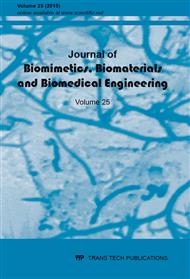p.3
p.12
p.19
p.25
p.41
p.54
p.69
p.73
p.83
Torque Analysis of IPMC Actuated Fin of a Micro Fish like Device Using Two-Way Fluid Structure Interaction Approach
Abstract:
In this paper, a numerical simulation of three dimensional model of IPMC actuated fin of a fish like micro device is presented using two-way fluid structure interaction approach. The device is towed by the surface vessel through a tow cable. Fin is acting as dorsal fin of the fish to control depth of the device and also acts as a stabiliser against its roll motion. Fin's displacement disturbs water flow streamlines around it, as a result velocity and pressure profile of fluid's domain changes around the actuated fin. As fin's position continuously changes throughout its actuation cycle, this makes it transient structural problem coupled with a fluid domain. Fin's displacement is received by the fluid and resulting fluid forces are received by the fin making it a two-way fluid structure interaction (FSI) problem. Such problems are solved by multi field numerical simulation approach. This multifield numerical simulation is performed in ANSYS WORKBENCH by coupling transient structural and Fluid Flow (CFX) analysis systems. It is desirous to determine the torque acting on the fin due to fluid forces through its actuation cycle by IPMC actuators. The objective of this study is to develop the methodology (two-way fluid structural interaction (FSI)) used to simulate the transient FSI response of the IPMC actuated fin, subjected to large displacement against different flow speeds. Efficacy of fin as depressor and riser is also required to be judged by monitoring the forces acting on wing in response to its displacement under IPMC actuation. Same approach is also applicable to the self-propelled systems.
Info:
Periodical:
Pages:
25-38
Citation:
Online since:
October 2015
Authors:
Price:
Сopyright:
© 2015 Trans Tech Publications Ltd. All Rights Reserved
Share:
Citation:


